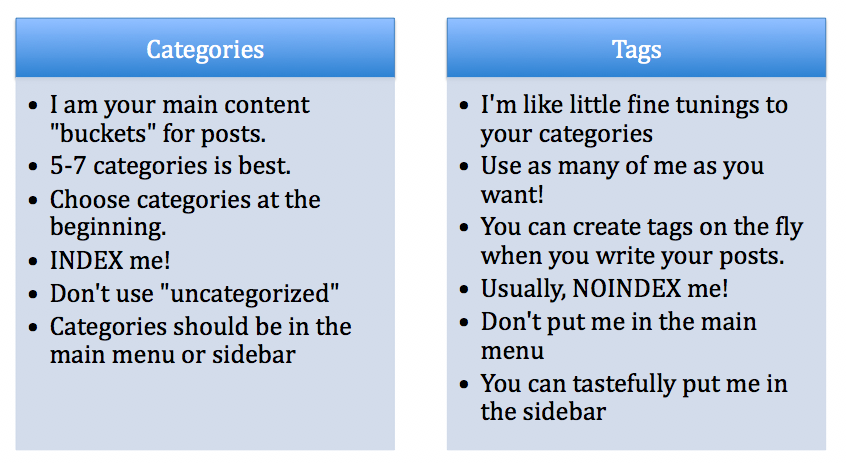 If someone were to ask you: “What is the difference between blog tags and blog categories?”, would you know the answer? Yes, there is a difference, though 90% of people don’t know what that difference actually is.
If someone were to ask you: “What is the difference between blog tags and blog categories?”, would you know the answer? Yes, there is a difference, though 90% of people don’t know what that difference actually is.
WordPress gives a pithy explanation: “Tags are similar to categories, but they are generally used to describe your post in more detail.” Let's dive in a bit more so you'll never again be at a loss for words when someone puts you on the spot with a question about tags and categories.
For a practical example to help illustrate the difference, consider the organization of a food blog:
Categories: Breakfast, Drinks, Snacks, Desserts, Vegetarian
Tags: Chicken, Beef, Almonds, Potatoes, Granola, Milk, Whipped Cream
A category is essentially your blog's Table of Contents and can bearranged in a hierarchical structure, often times with sub-categories. Topics should be broad enough to group many posts together, providing general, top-line information on what your blog is all about to help visitors quickly navigate through content. Generally 5-7 categories is a good number to shoot for.
You may be tempted to load as many categories into your blog as possible, but don't fall into this easy trap. Categories are meant for the reader, and having too many options to choose from will not only overwhelm them, but will actually make content more difficult to find. Rule of thumb: if you can’t organize your posts without using multiple categories, chances are your categories are too specific.
Tags, on the other hand, are a way of indexing common words on your site. These can be much more specific and there's really no limit to how many you can create. If you want to come up with new tags on the fly after writing a new blog post, go for it. Tags organize content based on specific details (e.g. ingredients) to micro-categorize your content. Tags are also not hierarchical and are frequently displayed in word clouds.

One major difference to remember is that categories are always necessary, whereas tags are not necessarily required.
Check back next week for Part II of this post, where we'll tell you about best practices, SEO, and how you can utilize tags and categories more effectively on your site.


